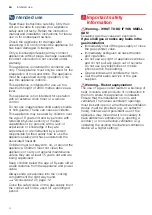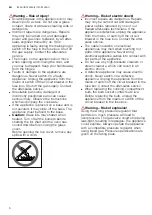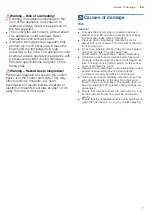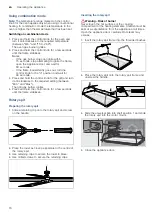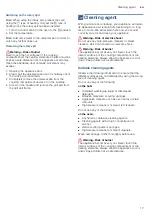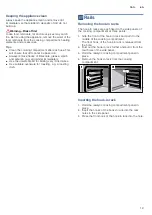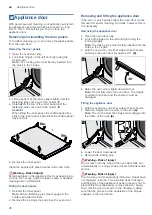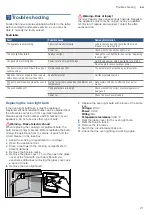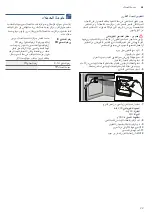
en
Cleaning agent
18
--------
Notes
■
Slight differences in colour on the front of the
appliance are caused by the use of different
materials, such as glass, plastic and metal.
■
Shadows on the door panels, which look like
streaks, are caused by reflections made by the
interior lighting.
■
Enamel is baked on at very high temperatures.This
can cause some slight colour variation. This is
normal and does not affect operation.
The edges of thin trays cannot be completely
enamelled. As a result, these edges can be rough.
This does not impair the anti-corrosion protection.
Surfaces in the cooking compartment
The side panels in the cooking compartment are self-
cleaning. You can tell this from the rough surface.
The cooking compartment floor, ceiling and back panel
are enamelled and have smooth surfaces.
Cleaning enamelled surfaces
Clean the smooth enamelled surfaces with a dish cloth
and hot soapy water or a vinegar solution. Then dry with
a soft cloth.
Soften baked-on food residues with a damp cloth and
soapy water. Use stainless steel wire wool or oven
cleaner to remove stubborn dirt.
Leave the cooking compartment open to dry after
cleaning.
Note:
Food residues can cause white deposits to form.
These are harmless and do not affect how the
appliance works. You can remove these residues using
lemon juice if required.
Cleaning self-cleaning surfaces
The self-cleaning surfaces are coated with a porous,
matte ceramic layer. This coating absorbs and dispels
splashes from baking and roasting while the appliance
is in operation.
If the self-cleaning surfaces no longer clean themselves
sufficiently and dark stains appear, they can be cleaned
using the cleaning function. To do this, refer to the
information in the relevant section.
Caution!
Do not use oven cleaner on self-cleaning surfaces. This
will damage the surfaces. If oven cleaner does get onto
these surfaces, dab it off immediately using water and a
sponge cloth. Do not rub the surface and do not use
abrasive cleaning aids.
Area
Cleaning
Appliance exte-
rior
Hot soapy water:
Clean with a dish cloth and then dry with a soft
cloth. Do not use glass cleaner or a glass scraper.
Stainless steel
front
Hot soapy water:
Clean with a dish cloth and then dry with a soft
cloth.
Remove flecks of limescale, grease, starch and
albumin (e.g. egg white) immediately. Corrosion
can form under such flecks.
Special stainless steel cleaning products suitable
for hot surfaces are available from our after-sales
service or from specialist retailers. Apply a very
thin layer of the cleaning product with a soft cloth.
Aluminium and
plastic
Glass cleaner:
Clean with a soft cloth.
Gas hob and pan
supports
Hot soapy water.
Use very little water. Water must not be allowed to
enter the appliance through the base of the burn-
ers.
Clean boiled-over liquids and spilt food immedi-
ately.
You can remove the pan supports. Do not clean
the pan supports in the dishwasher.
Gas burners, hot-
plate
Remove the burner cups and caps, clean them
with soapy water.
The gas outlet openings must remain free from
obstruction.
Ignition plugs: Small, soft brush.
The gas burners only work properly when the igni-
tion plugs are clean. Dry all parts thoroughly.
Ensure that they are positioned correctly when
they are refitted.
The burner caps are coated in black enamel. The
colour may change over time. This does not affect
their function.
Do not clean the burner caps in the dishwasher.
Enamel surfaces
(smooth surfaces)
Hot soapy water:
Clean with a dish cloth and then dry with a soft
cloth. Remove flecks of limescale, grease, starch
and albumin (e.g. egg white) immediately. Corro-
sion can form under such flecks.
Special stainless steel cleaning products suitable
for hot surfaces are available from our after-sales
service or from specialist retailers. Apply a very
thin layer of the cleaning product with a soft cloth.
Enamel surfaces
and self-cleaning
surfaces
Observe the instructions for the surfaces of the
cooking compartment that follow the table.
Gas burner, oven
and grill
Never clean the gas burners in the cooking com-
partment yourself.
Door panels
Hot soapy water:
Clean with a dish cloth and then dry with a soft
cloth.
Do not use a glass scraper or a stainless steel
scouring pad.
Glass cover for
the interior light-
ing
Hot soapy water:
Clean with a dish cloth and then dry with a soft
cloth.
If the cooking compartment is heavily soiled, use
oven cleaner.
Door seal
Do not remove.
Hot soapy water:
Clean with a dish cloth.
Do not scour.
Rails
Hot soapy water:
Soak and clean with a dish cloth or brush.
Accessories
Hot soapy water:
Soak and clean with a dish cloth or brush.
If there are heavy deposits of dirt, use a stainless
steel scouring pad.

